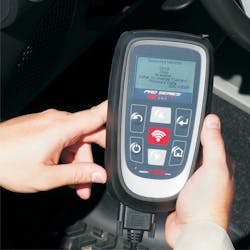The Tire Pressure Monitoring System is a safety system that warns the driver of a low tire pressure condition. It also warns the driver in the event of a system failure. The standard, direct TPMS is designed to indicate, with a solid light, a low pressure condition in one or more of the vehicle tires when the pressure inside the wheel falls below 75% of the placard [recommended inflation] pressure. A vehicle’s tires recommended inflation pressure is the calculated pressure based on tire size, type and load carrying capacity. This information is found on the “placard” that is adhered to a surface inside the driver’s door jamb. For the purpose of this tech tip, placard and recommended inflation pressure are used interchangeably.
We all remember the good old days before TPMS when we would slap on a set of oversized wheels, with low profile tires and as long as it looked good, and the tires didn’t rub; we were good to go! With TPMS however, we now have to make changes [via the OBDII] in order to keep the system operative, otherwise risk fines and penalties as a service provider.
There are two very common scenarios that you will encounter, and that will result in the need for placard adjustment.
1. Up-fitting a light truck from P-Metric Tires to Light Truck [LT] Tires. For example, a typical P265/70R17 tire supports 2,205 pounds at 32 PSI. The equivalent LT supports 2,219 pounds, only at 44 PSI. The truck’s new recommended inflation pressure would need to be programmed to 44 PSI to insure proper TPMS operation.
2. Plus Sizing from a smaller wheel diameter to larger. For example a common OE fitment is the 235/60 R15. A common plus size is the 245/40 R19. The OE placard is 35 PSI to support 1,642 pounds. The new recommended inflation pressure to support the same weight is 42 PSI, a 20% increase. If the technician were to do nothing, the TPMS light would illuminate only when one or more tires reached 26 PSI. Unfortunately the new, lower profile tire[s] would be nearly 40% underinflated at that point! The vehicle’s new placard needs to be programmed to 42 PSI to insure proper TPMS operation.
Changing the recommended inflation pressure [placard] value keeps the TPMS running as designed. That is, to trigger a low pressure warning when one or more of the tires falls below 75% of the placard pressure. Today’s vehicles require this programming step when an up-fitment or plus sizing changes the recommended inflation pressure significantly.
Provided by Scot Holloway, Bartec USA


